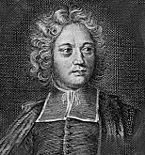| Profile | Major Works | Resources |
Charles-Irénée Castel, Abbé de Saint-Pierre. 1658-1743.

French cleric and writer, pioneer of the early
Enlightenment.
Of a noble Norman family and embracing the clerical life early, the Abbé
Saint-Pierre entered the service of the Duchess of Orleans in 1695, and was made
Abbot of Tiron in 1702. He became a frequent figure in literary salons in turn of century France.
In 1712, he accompanied the French ambassador Cardinal de Polignac to the peace
conference at Utrecht to put an end to the long War of Spanish Succession. The
difficulties presented by the negotiations of the final treaty prompted his most
famous tract, the Projét de paix perpétuelle, an outline of idealistic
system of international conferences and organizations, which would resolve
conflicts by argument and arbitration rather than war (which Saint-Pierre rooted
in a proposal by Sully & Henry IV a century earlier).
Thereafter, Saint-Pierre's life as a prolific writer (usually signed) on reform took wing, proposing scheme after scheme for overhauling government, administration, economy and social institutions usually along fully reasoned, if idealistic, presaging much of the optimistic Enlightenment spirit to come. A humanitarian social analyst, Saint-Pierre sought to explain phenomena like poverty in terms of circumstance and luck, rather than Divine retribution or moral failure, and set out projects to address and mitigate such circumstances. Saint-Pierre's numerous schemes were often bogged in pedantic detail, e.g. the operation of a government bureaus to solve theological disputes, the minutiae of educating monarchs, establishing girls' schools, or running a charity, etc. But some were prescient, e.g. in 1717, the Abbé de Saint-Pierre set out a proposal for a taille tarifée, a proportional income tax, to substitute the arbitrary tax assessment. Saint-Pierre's discourse on Polysynodie, extolling the government by councils (as practiced during much of the Orleanist regency) was unfortunately conjoined with an unbridled condemnation of the prior government and policies of Louis XIV. Saint-Pierre's rant was met coldly, and he was promptly expelled from the Acadèmie française in 1718.
Saint-Pierre was a leading member of the 1720s 'Club d'Entresol' of Abbé Alary in Paris, which included other early Enlightenment figures such as René Louis de Voyer, Marquis d'Argenson, which was closed down in 1731 by order of Cardinal Fleury. In 1733, Saint-Pierre began putting out his Ouvrajes, containing his numerous schemes and thoughts into print. After his death in 1743, Saint-Pierre's nephew dispatched the remaining mountain of manuscripts to Jean-Jacques Rousseau to sort through. Rousseau was immensely influenced by Saint-Pierre's work, although deriding him as pedantic and shallow.
Upon his death, the Academie's ban was still in force, which prevented the usual eulogy to be delivered. When the ban was finally lifted, three decades later, d'Alembert took it upon himself to deliver the belated eulogy at the Academie.
|
Resources on Abbé de Saint-Pierre
|
All rights reserved, Gonçalo L. Fonseca
